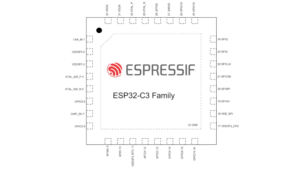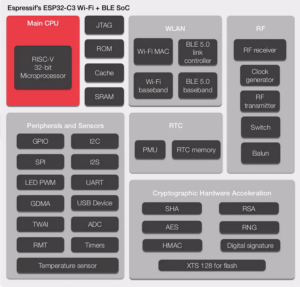It is not an exaggeration that the current wave of IoT devices owes a lot to the Espressif ESP8266 family of devices. That means a new member of this family is a big deal and it’s pretty exciting that the newest, the ESP32-C3, moves to a RISC-V core. We have a draft of the ESP32-C3 data sheetfor those ready to dig in.
ESP8266, Quick History
In 2014, The ESP8266 came to the scene, bundling a full WiFi package, including antenna, ROM, RAM, and a CPU into a package that integrated with Hayes modem-like command set for communicating with a host that could be as simple as an Arduino or less. Eventually, enough was learned about the core, a Tensilica Xtensa Diamond Standard 106Micro running at 80 MHz, that hackers were able to run their own code on board and often eliminate the “host” processor completely, often for under $10 at that time and in decline since.
ESP32 was the 2016 successor, bringing in Bluetooth and more powerful integrated CPU. Available as a chip or a (FCC-tested) module that included antennas, the most common configuration was dual-core, allowing a less cramped balance of a developer’s own code with the integrated feeding of the radio stack. The Xtensa LX6 cpu core was still not widely loved by programmers with toolchain issues remaining common.
Esp32-C3: Now with more RISC-V
Early in November 2020, we first got hints of a RISC-V design, the Bouffalo Labs BL602 family, making an attack on that market of low pin count, high integration devices striking a blow at the ESP32 price point of about $5. Late in November, we now have confirmation that (awkwardly named) ESP32-C3 is being released by Espressif as the newest member of their family, though details are only slowly coming out of China, as they do.
ESP32-C3 will be pin-compatible with the large ESP8266 family. It includes a 160Mhz 32-bit RISC-V core toreplace the Tensilica CPU. As you’d expect in 2020, b/g/n WiFi and Bluetooth Low-Energy (BLE) are table stakes. ESP32-C3 brings 400 kB of SRAM and 384 kB ROM.


We don’t yet know what RISC-V core they are using (SiFive, Nuclei, etc.) or if they’ve created their own. As this is likely to be a relatively humble RV32IMAC (or less!) design, we’d expect high degrees of compatibility with the wide variety of RISC-V tools that we already have. We don’t know if the trend of binary blobs (a problem being tackled by Pine64) will remain, but it’s likely they will given the regulatory landmine around radios.
With access to the wealth of dev tools, socket compatibility with ESP8266, and Espressif’s embrace of the maker communities, this device is sure to be a hit. Unfortunately, it’s a little too early for a stocking stuffer this year, but it’s one of a series of parts that’ll make RISC-V fun to follow in 2021.